Committee Approves Milwaukee Streetcar
Mayor offers historic address to council committee on streetcar and it gains their approval. Only one person speaks in opposition.
The proposed Milwaukee Streetcar starter system was advanced today at a marathon meeting of the Common Council’s Zoning, Neighborhoods & Development Committee. Four of the five members of the committee voted to approve using two tax-incremental financing (TIF) districts to fund the construction costs of the system following extensive positive public testimony and presentations by Mayor Tom Barrett, Department of City Development commissioner Rocky Marcoux (PDF), The Couture developer Rick Barrett, and The Couture architect Matt Rinka. The project is still on track for a December 16th Common Council vote and appears to be gaining supporters. Alds. Ashanti Hamilton and Willie Wade, Jr. added their names as co-sponsors of the legislation.
The Mayor’s Presentation
An all-hands-on-deck streetcar push by the mayor’s office had Barrett himself making a rare appearance before a Milwaukee Common Council committee. Mayors rarely address the council. According to Barrett, who has served in the position for more than a decade, this was the first time he could ever remember making a presentation to the council using a slideshow (which he drew laughs by noting it wasn’t a Marcoux-style presentation– known for their length, high energy and fast pace). The mayor’s presentation (PDF) focused on three key areas: why this project, why downtown and why now.
Why This Project?
Barrett’s hammered on the notion that the streetcar is a tool for economic development and a piece of a comprehensive transportation system.
The mayor noted that “we have to attain and attract more business” and that the streetcar would generate “investment and growth along and near the route.” He highlighted at length the success of similar systems in Portland, Seattle and other cities. As for the streetcar competing for scarce resources, including the federal funds that enable it, Barrett noted that “we have not starved our local streets and we don’t intend to.” Barrett pointed out that under his administration, the street replacement cycle has gone from 108 years per street to 62 years.
He went on to explain the legislation authorizing the $54.9 million in federal funds mandates the funds must go for a streetcar system. It would take an act of Congress to reallocate them to something else. The mayor indicated his belief that if Milwaukee doesn’t spend the funds on a streetcar, cities like Cincinnati or St. Louis would push for the funds to be re-allocated to their streetcar projects.
Why Downtown?
The mayor used a data-driven argument to show the project would “get it right out of the gate.” Downtown, he noted, is the city’s central business district, with 80,000 workers, 25,000 residents and 5.5 million annual visitors. The route would pass 100 percent of downtown hotels, 90 percent of occupied office space, 90 percent of occupied retail space, 77 percent of parking stalls, 77 percent of downtown housing, 90 percent of downtown attractions and all of downtown’s 20 largest employers
Citing the census bureau’s average-weighted density figure, the mayor noted that Milwaukee ranks 14th and is the highest-ranked city without a fixed rail transit system. In the top 40 cities by average-weighted density, the only cities without fixed rail transit are San Antonio, Fresno, El Paso, Wichita and Raleigh. Barrett argued that much of the metropolitan region doesn’t have the density to support a streetcar system, but Downtown and many areas around it do.
Why Now?
Barrett’s argument here was pretty straightforward. The council had previously voted to authorize engineering the streetcar to 60 percent completion. After the legal challenges put forth by the state, they’re now at that point and ready to move forward. He noted they’ve worked through the utilities challenges (detailed below). As he referenced earlier in his presentation, the mayor is looking to continue the momentum from the $5 billion in projects since 2005, including those completed, under construction and planned for development.
Barrett ended his presentation by stating “it is important for us to double down on the future of this city.”
Utilities Cost
The cost to relocate the utilities for the streetcar project has been an extremely contentious issue. Initial cost estimates put the relocation expense as high as $70 million. A legal challenge continues by the city attorney against the state Public Service Commission regarding its decision that the city must pay the entire cost of relocation (which would be unique to public works projects in this state). But Barrett noted that city engineering work has already reduced those costs by nearly $50 million. All parties involved in the discussion have agreed that as of today the relocation costs for the project would be $22.7 million, Barrett said. He noted that the utilities (of which the biggest is We Energies) have indicated a number of minor route modifications that would drive down utilities costs by millions more. The mayor stated that the city is actively working on those modifications as part of its engineering work. “I am 100 percent confident that number is going to come down by millions of dollars,” Barrett said, concluding his remarks.
Streetcar Cost Breakdown
Barrett presented a detailed cost breakdown of the streetcar during his presentation this morning. Costs
- Maintenance facility: $7.5 million
- 4 Vehicles: $17.6 million
- Phase 1 route: $73.8 million
- Phase 2 route (Lakefront extension): $25 million
Funding Sources
- Federal ISTEA funding : $54.9 million
- Federal TIGER grant: $10 million
- Cathedral Place #49 TIF: $9.7 million
- Erie/Jefferson Riverwalk TIF #56: $18.3 million
- East Michigan St. TIF #82: $31.0 million
Project Schedule
The mayor’s presentation laid out the following schedule for the project.
- Vehicle selection: 2015
- Final design: 2015
- Construction: 2015-2017
- Streetcar operations: 2018
Milwaukee Journal Sentinel Called to the Table
In a strange twist of standard operating procedure, Ald. Willie Wade asked if a reporter from the Milwaukee Journal Sentinel was present, and then called that reporter to the table to answer questions. The paper’s new city hall reporter, Crocker Stephenson, came forward (under no legal requirement to do so, as chairman Jim Bohl noted). Wade rhetorically asked Stephenson if he had heard Marcoux state that the funds couldn’t be used for anything else. He then went on to ask why the Milwaukee Journal Sentinel keeps printing that they could be, which drew lots of laughter (and some gasps) from the room. Ald. Robert Bauman interrupted to note that he didn’t think it was the fault of the paper, but some of his colleagues (clearly a dig at Ald. Robert Donovan and maybe others) distributing false information. The strange exchange resulted in lots of laughs, including by Stephenson and Wade, but also drove home a oft-misunderstood point. According to federal law dating back to 2011, the $54.9 million in federal funds cannot be used for anything other than a streetcar project in Milwaukee. The only way to change this would be to get Congress to re-appropriate the money. The state’s rejection of the $823 million in high speed rail funds illustrates what is the more likely result: when one state rejects the funds they go to similar projects in other districts.
Redevelopment Authority Bonding
In his ongoing quest to kill the project, Donovan has put forth the argument that the use of redevelopment authority (RACM) bonds to pay for the infrastructure is a way to avoid any referendum on the project. The bonds by the redevelopment authority offer a better deal for the taxpayers because they’re not secured by city tax revenues, but instead by project revenues. Marcoux noted that they don’t always use RACM bonding, but it is commonly used and is nothing unusual.
Future Extensions
The city is eager to get to work on the extensions for the project. Marcoux noted the mayor has directed the project team to move forward with extension planning immediately in 2015. Marcoux intends to issue a request-for-proposals in January 2015 to plan the four extensions (UWM, Bronzeville, Marquette/Avenues West and Walker’s Point/Bay View/airport). Responding to a question from Alderman Jose Perez, Marcoux noted how eager they are to get extensions in the ground (as the mayor said during his speech, it is a “trojan horse” designed to get into the ground and expanded quickly). Marcoux had earlier stated that they are working on a timeline that could have extensions breaking ground before the first phase even finishes construction.
Speaking in Favor
A number of people spoke in favor of the proposed streetcar system. I’ve included them below and the organizations they noted they were representing. Speakers included Michael Cudahy (Discovery World), Juli Kaufmann (Fix Development), Bill Sell (citizen), Jerome Knapp (BID #8 – Historic King Drive), Beth Wierick (BID #21 – Milwaukee Downtown), Nick Johnson (Hilton Garden Inn), Dan Bukiewicz (Milwaukee Building and Construction Trades Council), Dr. Eve Hall (African American Chamber of Commerce), Gary Grunau (citizen and owner of Schlitz Park), Earl Buford (Milwaukee Area Workforce Investment Board), Teresa Thomas-Boyd (citizen), Jackie Ivy (citizen).
Not speaking, but registering themselves in support included Jorge Franco (Hispanic Chamber of Commerce), Stacie Callies (Westown Association, BID #5 – Westown), Nancy O’Keefe (Historic Third Ward Association, BID #2 – Historic Third Ward), Ken Kramer (citizen), Tony Neira (laborers local #113), Dave Reid (citizen and Urban Milwaukee Publisher).
The Only Opposition
Alderman Tony Zielinski was the only person to speak in opposition to the project. Zielinski, who does not serve on the committee, attempted to introduce an amendment to split the new East Michigan St. TIF district in two. This change would allow for individual votes on The Couture financing and streetcar financing. Finding no support from the committee to introduce his amendment, Zielinski stated that he would attempt to introduce it on the council floor. During Zielinski’s testimony, alderman Bauman asked of Zielinski if he heard developer Rick Barrett say he could not move forward with The Couture unless the streetcar project also happened. Zielinski said he did. Bauman then asked Zielinski if he thought Barrett was a “liar or incompetent?” Zielinski said he disagreed with the characterization, but clearly things were getting testy. Alderman Bohl stepped in to ask for civility. Zielinski went on to say that he had an article from 2012 that said the project could move forward without anything else (waving a BizTimes article in his hand), and that he thought things could change again. This drew no response from the committee.
New Streetcar Supporters
The streetcar project has long had two active champions on the council, Bauman and Nik Kovac. But it appears others are jumping aboard. Alderman Hamilton asked to be added as a co-sponsor and noted “it really is time for us to embrace something that is bold enough to have a reverberating impact across the city. Downtown is everybody’s neighborhood. This is where everybody comes.” Hamilton also noted that he was sitting in on the committee for Kovac, who is out of town. Alderman Wade also asked to be added as a co-sponsor. Clearly aimed at referendum backers alderman Donovan and Davis, Wade stated “this is why we are elected. To make bold, courageous decisions, even when we’re staring in the face of opposition. That’s what leaders do.”
Today’s Vote
The committee, including committee substitute Ashanti Hamilton, voted 4 to 1 to approve both of the TIF distrcts as financing mechanisms for the streetcar’s construction (and for the public infrastructure portion of The Couture). Aldermen Bauman, Hamilton, Perez and Wade voted in favor. Committee chair Jim Bohl voted in opposition.
Moving Forward
The project will be voted on Wednesday morning by the Public Works Committee chaired by Bauman. That committee could possibly vote against the proposal, although its impact on the eventual full council approval of the project is unclear. The Public Works Committee is made up of streetcar sponsors alderman Bauman and Wade, mayoral candidates and streetcar opponents aldermen Davis and Donovan and Bohl, who voted against the project today, but was cordial in allowing it to move forward. Regardless of what happens on Wednesday, the project will be heard in a full meeting of the common council on December 16th.
Streetcar Map and Renderings
Urban Milwaukee Streetcar Coverage
- Committee Takes No Action on Streetcar – Jeramey Jannene – December 10th, 2014
- Committee Approves Milwaukee Streetcar – Jeramey Jannene – December 9th, 2014
- RACM Approves Tax Funding for Streetcar – Michael Horne – December 8th, 2014
- How to Sell the Streetcar – Michael Horne – November 28th, 2014
- Next Stops for the Streetcar – Michael Horne – November 24th, 2014
- Barrett Moving Forward with Streetcar – Jeramey Jannene – November 18th, 2014
- Who Will Be Streetcar Operator – Michael Horne – May 8th, 2014
- A Streetcar Named Cooperation? – Dave Reid – April 27th, 2014
- How a Streetcar Spurs Development – Angie Schmitt – November 3rd, 2013
- Streetcar Social – Michael Horne – September 12th, 2013
- Mayor Says Streetcar is a “Trojan Horse” – Michael Horne – April 17th, 2013
- Whoops, We Changed Our Mind – Dave Reid – September 27th, 2012
- Battle of the Bobs: Donovan vs Bauman Streetcar Press Conference – Jeramey Jannene – May 18th, 2012
- Important Hoan Bridge and Milwaukee Streetcar Meetings This Week – Dave Reid – November 14th, 2011
- Milwaukee Streetcar Passes Common Council – Jeramey Jannene – July 26th, 2011
- Keep the Milwaukee Streetcar Moving Forward – Jeramey Jannene – July 8th, 2011
- Milwaukee Streetcar at Apex – Jeramey Jannene – June 16th, 2011
- Milwaukee Streetcar Takes Key Step Forward – Jeramey Jannene – May 6th, 2010
- Milwaukee Streetcar Meeting This Thursday – Jeramey Jannene – October 5th, 2009
- Milwaukee Streetcar Routes Unveiled by Mayor Barrett – Jeramey Jannene – September 21st, 2009
- Milwaukee Streetcar Round-Up – Jeramey Jannene – April 19th, 2009
- Vote for your Favorite Milwaukee Streetcar Route – Jeramey Jannene – March 25th, 2009
- Design Your Own Streetcar Route – Jeramey Jannene – March 23rd, 2009
- Streetcars Coming to Milwaukee – Dave Reid – March 14th, 2009
Have an Opinion?
Let the Common Council and Mayor know what you think about the project via the form on our website. We’ll keep it open until the expected project vote on December 16th.
If you think stories like this are important, become a member of Urban Milwaukee and help support real, independent journalism. Plus you get some cool added benefits.
More about the Milwaukee Streetcar
For more project details, including the project timeline, financing, route and possible extensions, see our extensive past coverage.
- Streetcar Begins Daily Service To The Couture, BRT Will Soon Follow - Jeramey Jannene - Apr 11th, 2024
- Milwaukee’s Three Streetcar Extensions Need Mayoral Direction - Jeramey Jannene - Nov 8th, 2023
- Transportation: Streetcar Extension Opens Sunday - Jeramey Jannene - Oct 28th, 2023
- Ride Along On Streetcar Extension Before It Opens - Jeramey Jannene - Oct 11th, 2023
- Lakefront Streetcar Extension Opens October 29 - Jeramey Jannene - Aug 22nd, 2023
- Streetcar Ridership Has Climbed For 27 Straight Months Year-Over-Year - Jeramey Jannene - Jul 28th, 2023
- Transportation: Harley-Davidson Is New Streetcar Sponsor - Jeramey Jannene - Jul 7th, 2023
- Committee Backs 4 Streetcar Extensions - Jeramey Jannene - Jun 28th, 2023
- Garbage Truck Crashes Into Streetcar - Jeramey Jannene - Mar 27th, 2023
- Eyes on Milwaukee: City Has $16 Million Plan For Downtown Plaza - Jeramey Jannene - Mar 10th, 2023
Read more about Milwaukee Streetcar here
Political Contributions Tracker
Displaying political contributions between people mentioned in this story. Learn more.
- December 23, 2020 - Tom Barrett received $500 from Rocky Marcoux
- December 27, 2018 - Tom Barrett received $1,000 from Rick Barrett
- December 22, 2018 - Tom Barrett received $500 from Rocky Marcoux
- November 16, 2018 - Tom Barrett received $400 from Jorge Franco
- June 21, 2018 - Tom Barrett received $3,000 from Michael Cudahy
- April 17, 2018 - Ashanti Hamilton received $100 from Rick Barrett
- December 29, 2017 - Tom Barrett received $500 from Rocky Marcoux
- December 13, 2017 - Tom Barrett received $1,500 from Rick Barrett
- November 8, 2017 - Tom Barrett received $400 from Jorge Franco
- March 1, 2017 - Tom Barrett received $400 from Rocky Marcoux
- March 30, 2016 - Tom Barrett received $3 from Bill Sell
- March 20, 2016 - Tom Barrett received $5 from Bill Sell
- March 3, 2016 - Ashanti Hamilton received $797 from Rick Barrett
- February 14, 2016 - Tom Barrett received $5 from Bill Sell
- February 11, 2016 - Robert Bauman received $50 from Stacie Callies
- January 13, 2016 - Ashanti Hamilton received $20 from Juli Kaufmann
- November 2, 2015 - Tom Barrett received $2,600 from Rick Barrett
- October 29, 2015 - Willie Wade received $100 from Gary Grunau
- September 14, 2015 - Tom Barrett received $400 from Jorge Franco
- August 6, 2015 - Tom Barrett received $25 from Jorge Franco
- July 9, 2015 - Tom Barrett received $3,000 from Michael Cudahy
- May 7, 2015 - Nik Kovac received $144 from Gary Grunau
- March 19, 2015 - Robert Bauman received $100 from Gary Grunau
- August 25, 2014 - Robert Bauman received $100 from Gary Grunau
Eyes on Milwaukee
-
Church, Cupid Partner On Affordable Housing
 Dec 4th, 2023 by Jeramey Jannene
Dec 4th, 2023 by Jeramey Jannene
-
Downtown Building Sells For Nearly Twice Its Assessed Value
 Nov 12th, 2023 by Jeramey Jannene
Nov 12th, 2023 by Jeramey Jannene
-
Immigration Office Moving To 310W Building
 Oct 25th, 2023 by Jeramey Jannene
Oct 25th, 2023 by Jeramey Jannene


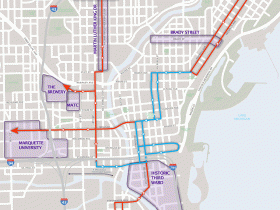
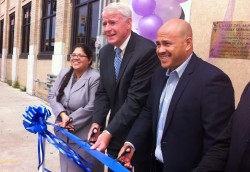
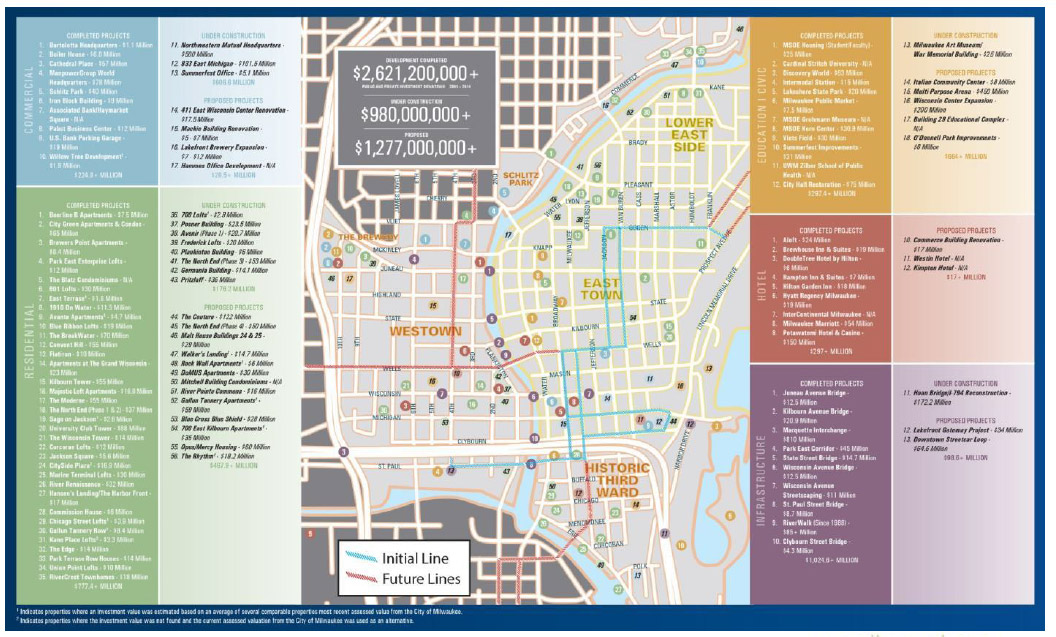
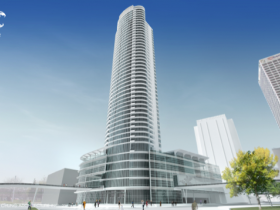
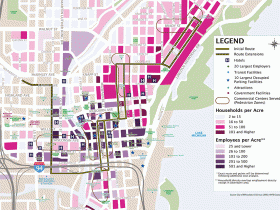
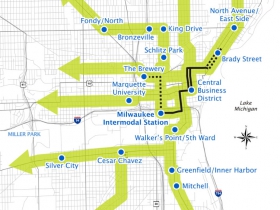
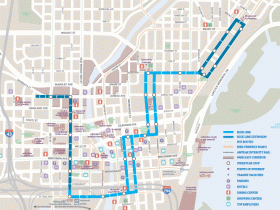
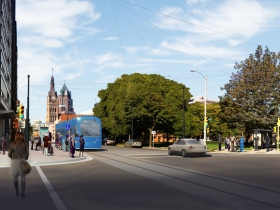
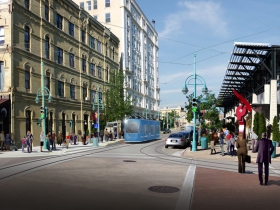
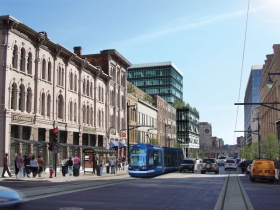



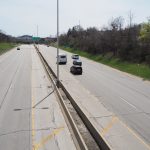











Looks like a colossal waste of money, particularly when there are greater needs. Need to move Milwaukee forward but not on rails. It’s a money loser everywhere they’ve been installed.
Woot!
Thanks for the great detailed article!
Sounds really good and the route looks great. Hopefully the extensions get ironed out quick.
When they say, “The route would pass 100 percent of downtown hotels”, are they talking about after three phases? because the first phase on the map looks like it doesn’t come all that close to the Hilton, Aloft, or the Hyatt. In fact, it’s a couple of blocks from Intercontinental and the to-be-completed Kimpton in the Third Ward. Maybe the define passing a hotel as being with 6-8 blocks?
When all of the facts and figures come together, you can easily see why this is a good thing for Milwaukee. It also goes to show that Alderman Zielinski is completely out of step.
Great reporting.
It’s too bad that Alderman Zielinski is opposed to a modern transit system, economic development, and all the jobs that will come with — not to mention the positioning of the City as a more attractive, livable place for our best and brightest to live and work. I wonder what progressive Bay View will make of this in the next election cycle?
Hang in there fans of Milwaukee, in Cincinnati we have dealt with nearly the same thing you are experiencing, and in the end we fought, we won, and metropolitan Cincinnati will join other revolutionary Midwestern cities in supporting a better future for our kids. It looks like you too have a strong mayor to push this along, just like we did, Oklahoma City did, Atlanta, KC, Washington DC, New Orleans, Fort Lauderdale, Tuscon, Seattle, Portland, and countless others.
The fight is long. And intense. But the outcome is worth it. Don’t fall prey to the aggressive suburban pessimists. You deserve a thriving downtown, and the pessimists won’t appreciate that, anyways.
Well this is exciting! To see so many “hop on board” is really encouraging. Downright inspiring. Especially Ald. Wade – he’s got some cojones.
Ald Zielinski seemed, ironically, like one of those pathetic strawman bureaucrats in an Ayn Rand novel. Holding up the paper as an entire room of competent people ignored him was quite theatrical. I could almost hear him blubbering “B-but, Donovan said . . . it’s a trolley!”; consummate spineless politician is he.
Partypanther (#3), the hotel claim assumes the line up 4th Street (from St. Paul to Juneau) is built. If that (and the first phase) is completed, the streetcar would pass within one quarter mile (about 2 NS blocks or 4 EW blocks) of every downtown hotel.
One quarter mile is about the limit of what many people consider “within walking distance”.
You know what else is a money loser, G.R. Gray? Roads. Should we stop paving those as well?
Neither roads nor transit lose money. They both are a public cost that lead indirectly to an increase a region’s GDP (moving people and goods = $s). It’s the same with schools, hospitals, police and fire, which all are elements that increase GDP.